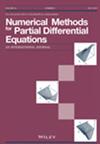带波动算子的非线性Schrödinger方程的保守EQ1rot非协调有限元
IF 1.7
3区 数学
Q1 MATHEMATICS, APPLIED
引用次数: 0
摘要
本文章由计算机程序翻译,如有差异,请以英文原文为准。
Conservative EQ1rot nonconforming FEM for nonlinear Schrödinger equation with wave operator
In this paper, we consider leap‐frog finite element methods with EQ1rot$$ {\mathrm{EQ}}_1^{\mathrm{rot}} $$ element for the nonlinear Schrödinger equation with wave operator. We propose that both the continuous and discrete systems can keep mass and energy conservation. In addition, we focus on the unconditional superconvergence analysis of the numerical scheme, the key of which is the time‐space error splitting technique. The spatial error is derived τ$$ \tau $$ independently with order O(h2+hτ)$$ O\left({h}^2+ h\tau \right) $$ in H1$$ {H}^1 $$ ‐norm, where h$$ h $$ and τ$$ \tau $$ denote the space and time step size. Then the unconditional optimal L2$$ {L}^2 $$ error and superclose result with order O(h2+τ2)$$ O\left({h}^2+{\tau}^2\right) $$ are deduced, and the unconditional optimal H1$$ {H}^1 $$ error is obtained with order O(h+τ2)$$ O\left(h+{\tau}^2\right) $$ by using interpolation theory. The final unconditional superconvergence result with order O(h2+τ2)$$ O\left({h}^2+{\tau}^2\right) $$ is derived by the interpolation postprocessing technique. Furthermore, we apply the proposed leap‐frog finite element methods to solve the logarithmic Schrödinger equation with wave operator by introducing a regularized system with a small regularization parameter 0
求助全文
通过发布文献求助,成功后即可免费获取论文全文。
去求助
来源期刊
CiteScore
7.20
自引率
2.60%
发文量
81
审稿时长
9 months
期刊介绍:
An international journal that aims to cover research into the development and analysis of new methods for the numerical solution of partial differential equations, it is intended that it be readily readable by and directed to a broad spectrum of researchers into numerical methods for partial differential equations throughout science and engineering. The numerical methods and techniques themselves are emphasized rather than the specific applications. The Journal seeks to be interdisciplinary, while retaining the common thread of applied numerical analysis.

 求助内容:
求助内容: 应助结果提醒方式:
应助结果提醒方式:


